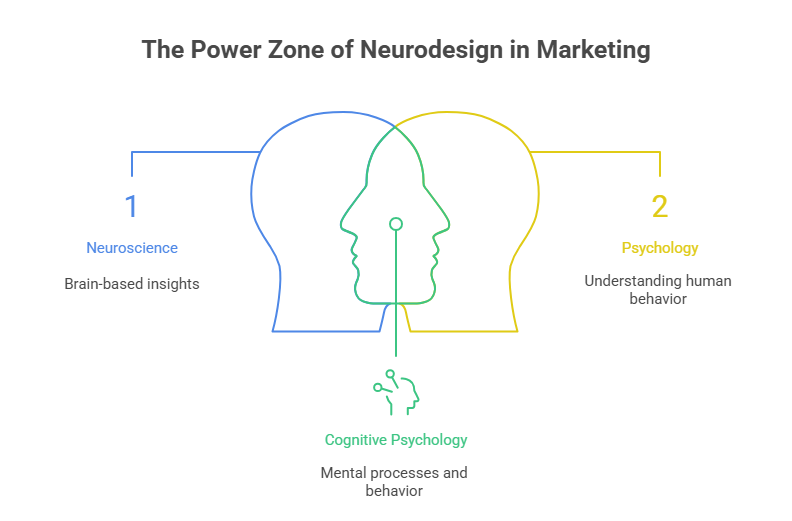
What if you could design ads that your audience’s brain couldn’t resist? That’s exactly what neurodesign in marketing is all about. In today’s fast-paced digital landscape, it’s not enough to just be creative—you need to be scientifically persuasive. By combining neuroscience, psychology, and design principles, marketers can craft experiences that tap into instinct, emotion, and cognition to drive engagement and conversions.
Welcome to the world where visual psychology in ads, emotional triggers in UX, and brain science for conversion meet. This blog explores how UX based on neuroscience can influence buyer behavior, boost ad performance, and reshape the future of conversion-focused design.

What Is Neurodesign in Marketing?
Neurodesign in marketing refers to the use of neuroscientific principles to design visuals, layouts, and user experiences that align with how the human brain processes information and makes decisions. It integrates disciplines like cognitive psychology, behavioral science, and human-computer interaction.
The idea is simple: if we understand how people see, feel, and react, we can design marketing assets—ads, websites, landing pages—that speak directly to the subconscious mind. In fact, 95% of purchase decisions are subconscious, according to Harvard Business School professor Gerald Zaltman.
This makes neurodesign in marketing not just an art—but a conversion science.

Visual Psychology in Ads: Why It Matters
Visual psychology in ads focuses on how colors, layout, typography, and imagery influence user perception and behavior. Our brains process visuals 60,000 times faster than text. So, what we see first in an ad often determines whether we scroll, click, or convert.
Let’s break down a few neurodesign tactics rooted in visual psychology in ads:
- Color: Red creates urgency (think sales), blue builds trust (think finance), and green signals calm (think wellness).
- Visual Hierarchy: Our eyes naturally follow a Z or F pattern. Smart marketers place CTAs and headlines accordingly.
- Faces & Eyes: Human faces, especially with visible emotions or eye contact, grab attention instantly.
By combining these elements, designers apply brain science for conversion—capturing attention, guiding the eye, and pushing toward action.
Emotional Triggers in UX: Winning Hearts and Clicks
Emotion plays a central role in decision-making. According to Antonio Damasio, a renowned neuroscientist, “We are not thinking machines that feel, we are feeling machines that think.”
Emotional triggers in UX are design elements that tap into fear, joy, trust, curiosity, or urgency to provoke action. When used ethically, these triggers can dramatically improve performance.
Examples:
- Fear of Missing Out (FOMO): Limited-time offers or stock countdowns.
- Trust Elements: Testimonials, security badges, and social proof.
- Joy and Surprise: Delightful micro-interactions or gamified experiences.
Incorporating these emotional triggers in UX helps brands connect on a deeper level and motivate action beyond logic.
Brain Science for Conversion: The Real Psychology of Buying
Brain science for conversion isn’t guesswork—it’s grounded in measurable neural responses. Marketers can leverage fMRI studies, eye-tracking, and biometric feedback to understand what users feel, where they focus, and why they act.
Here are some brain-based design insights:
- Cognitive Ease: The brain prefers simplicity. Clear navigation and uncluttered layouts increase conversions.
- Mirror Neurons: Seeing someone use a product creates empathy and a desire to imitate.
- Reward Systems: Scarcity and exclusivity trigger dopamine release—pushing users to act fast.
When you align design with brain science for conversion, you go beyond aesthetics to influence real behavior.
UX Based on Neuroscience: Designing for the Subconscious
Designing a UX based on neuroscience means structuring user flows, interfaces, and content to match how the brain thinks and behaves. It includes everything from first impressions to micro-interactions.
Key Principles of UX Based on Neuroscience:
- First Glance Impression (0.05 Seconds): Users decide whether to stay almost instantly.
- Cognitive Load Management: Too many options lead to paralysis. Streamline choices.
- Predictable Navigation: Familiar layouts reduce stress and improve engagement.
- Sensory Feedback: Subtle animations, sounds, or haptics enhance the experience.
A well-executed UX based on neuroscience guides users naturally, making actions feel effortless and intuitive—which ultimately boosts conversions.
Real-World Application: Neurodesign in High-Converting Ads
Let’s look at a real-world example. A fintech app redesigned its landing page using principles of neurodesign in marketing, focusing heavily on visual psychology in ads and emotional triggers in UX.
Changes Made:
- Switched CTA color from grey to bold green
- Added trust signals like encryption badges and media mentions
- Simplified copy and added user emotion photos
- Used F-pattern layout with strategic image placement
Results:
- Conversion rate increased by 48%
- Bounce rate dropped by 27%
- Time on page increased by 34%
These gains weren’t due to random design changes—but the science of brain science for conversion and UX based on neuroscience.
How to Implement Neurodesign in Your Campaigns
Want to start using neurodesign in marketing right away? Here’s your step-by-step game plan:
1. Conduct Visual Audits
Review your current creatives for alignment with visual psychology in ads. Look for clutter, poor hierarchy, and weak CTAs.
2. Map Emotional Triggers
Identify which emotions your audience responds to—fear, excitement, trust—and build emotional triggers in UX around them.
3. Simplify and Guide
Use layout patterns (Z or F), minimal copy, and high-contrast buttons. Apply brain science for conversion to focus user attention.
4. Test with Real Users
Use A/B testing, heatmaps, and even biometric feedback if possible. See what works—don’t guess.
5. Make It Personal
Emotionally intelligent ads that adapt or personalize content based on behavior win more often.
The Future of UX Based on Neuroscience
As attention spans shrink and competition intensifies, UX based on neuroscience will become a competitive necessity, not a luxury. With AI tools like attention heatmap predictors and biometric-ready design software, neurodesign in marketing will only get more precise.
Upcoming trends include:
- AI-generated neuro-optimized designs
- Emotion AI for real-time feedback
- Brain-UX integrations for wearable tech
- Hyper-personalized experiences based on neuro-profiles
The combination of data, design, and neuroscience will drive brain science for conversion deeper into marketing playbooks.
Conclusion
In a world of digital overload, the brands that understand the brain will win. Neurodesign in marketing is not just a buzzword—it’s a proven method for influencing behavior, driving conversions, and creating memorable experiences.
By mastering visual psychology in ads, using emotional triggers in UX, and building a UX based on neuroscience, you can create content that doesn’t just inform—it compels. And when you align design with brain science for conversion, every pixel has a purpose.
Ready to apply neurodesign to your next campaign? Let our team craft high-converting ad creatives using the science of the human brain.
Ready to deliver truly personalized experiences? Contact Us to build hyper-personalized campaigns that convert.
If you’re a business based in South Delhi looking to strengthen your online presence, partnering with the right digital team can make all the difference. At Morphiaas, we’re more than just an SEO company in South Delhi—we’re a growth-focused partner offering complete digital solutions.
As a leading digital marketing agency in South Delhi, we specialize in SEO, performance marketing, and web design tailored to your goals. Our work as an online marketing agency in South Delhi is backed by data, strategy, and a deep understanding of the local market. Whether you need a skilled web designer in South Delhi to revamp your website or a creative SEO agency in South Delhi to boost your search rankings, we’ve got you covered.
Recognized as a top web designing company in South Delhi, we blend aesthetics with functionality to create high-converting websites. From delivering impactful SEO services in South Delhi to serving growing brands as a digital marketing agency in Saket, we’re committed to your success. Looking for the best web designing company in South Delhi or experienced ad agencies in South Delhi? Let Morphiaas be your trusted partner in digital growth




